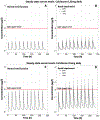Consensus Statement Regarding the Efficacy and Safety of Long-Term Low-Dose Colchicine in Gout and Cardiovascular Disease
- PMID: 34416165
- PMCID: PMC8688259
- DOI: 10.1016/j.amjmed.2021.07.025
Consensus Statement Regarding the Efficacy and Safety of Long-Term Low-Dose Colchicine in Gout and Cardiovascular Disease
Abstract
Over the last decade, evidence has demonstrated that long-term, low-dose colchicine (0.5 mg daily) is effective for preventing gout flare and cardiovascular (CV) events in a wide range of patients. Given the potentially expanding use of colchicine in CV disease, we here review and update the biologic effects and safety of colchicine based on recent data gathered from bench and pharmacodynamic studies, clinical reports, controlled clinical trials, and meta-analyses, integrated with important studies over the last 50 years, to offer a consensus perspective by experts from multiple specialties familiar with colchicine's long-term use. We conclude that the clinical benefits of colchicine in gout and CV disease achieved at low dose do not sustain serum levels above the upper limit of safety when used in patients without advanced renal or liver disease or when used concomitantly with most medications. Further, data accrued over the last 50 years strongly suggest that the biologic effects of long-term colchicine do not increase the risk of cancer, sepsis, cytopenia, or myotoxicity.
Keywords: Colchicine; Coronary disease; Gout; Safety; Tolerance.
Copyright © 2021 Elsevier Inc. All rights reserved.
Figures


Similar articles
-
Colchicine in Gout: An Update.Curr Pharm Des. 2018;24(6):684-689. doi: 10.2174/1381612824999180115103951. Curr Pharm Des. 2018. PMID: 29336252 Review.
-
Cardiovascular safety risks associated with gout treatments.Expert Opin Drug Saf. 2020 Sep;19(9):1143-1154. doi: 10.1080/14740338.2020.1804551. Epub 2020 Aug 12. Expert Opin Drug Saf. 2020. PMID: 32731769 Review.
-
Colchicine today.Joint Bone Spine. 2006 Dec;73(6):672-8. doi: 10.1016/j.jbspin.2006.03.006. Epub 2006 Sep 1. Joint Bone Spine. 2006. PMID: 17067838 Review.
-
Advances in the proper use of colchicine and adapting dosages in other countries: comment on the article by Terkeltaub et al.Arthritis Rheum. 2010 Oct;62(10):3126-7; author reply 3127-8. doi: 10.1002/art.27641. Arthritis Rheum. 2010. PMID: 20617519 No abstract available.
-
Open-label randomised pragmatic trial (CONTACT) comparing naproxen and low-dose colchicine for the treatment of gout flares in primary care.Ann Rheum Dis. 2020 Feb;79(2):276-284. doi: 10.1136/annrheumdis-2019-216154. Epub 2019 Oct 30. Ann Rheum Dis. 2020. PMID: 31666237 Free PMC article. Clinical Trial.
Cited by
-
Neoisoastilbin Ameliorates Acute Gouty Arthritis via Suppression of the NF-κB/NLRP3 Pathway.Evid Based Complement Alternat Med. 2023 Feb 14;2023:7629066. doi: 10.1155/2023/7629066. eCollection 2023. Evid Based Complement Alternat Med. 2023. PMID: 36824696 Free PMC article.
-
Duration of Disease and Long-Term Outcomes in Patients With Difficult-To-Treat Recurrent Pericarditis: A Chronic Condition Treated With Nonsteroidal Anti-Inflammatory Drugs, Colchicine, Corticosteroids, and Anti-Interleukin-1 Agents.ACR Open Rheumatol. 2025 Jan;7(1):e11776. doi: 10.1002/acr2.11776. ACR Open Rheumatol. 2025. PMID: 39846221 Free PMC article.
-
Anti-inflammatory therapy in atherosclerotic cardiovascular disease: Current reappraisal.Indian Heart J. 2023 Nov-Dec;75(6):391-397. doi: 10.1016/j.ihj.2023.10.007. Epub 2023 Oct 26. Indian Heart J. 2023. PMID: 37890557 Free PMC article. No abstract available.
-
Revitalizing Colchicine: Novel Delivery Platforms and Derivatives to Expand Its Therapeutic Potential.Int J Mol Sci. 2025 Aug 6;26(15):7591. doi: 10.3390/ijms26157591. Int J Mol Sci. 2025. PMID: 40806717 Free PMC article. Review.
-
Colchicine for secondary prevention of ischaemic stroke and atherosclerotic events: a meta-analysis of randomised trials.EClinicalMedicine. 2024 Oct 8;76:102835. doi: 10.1016/j.eclinm.2024.102835. eCollection 2024 Oct. EClinicalMedicine. 2024. PMID: 39431112 Free PMC article.
References
-
- Duckworth D. A Treatise on Gout. London: Griffin; 1889.
-
- Wallace SL, Singer JZ. Review: systemic toxicity associated with the intravenous administration of colchicine–guidelines for use. J Rheumatol 1988;15(3):495–9. - PubMed
-
- Terkeltaub RA, Furst DE, Bennett K, Kook KA, Crockett RS, Davis MW. High versus low dosing of oral colchicine for early acute gout flare: twenty-four-hour outcome of the first multicenter, randomized, double-blind, placebo-controlled, parallel-group, dose-comparison colchicine study. Arthritis Rheum 2010;62(4):1060–8. - PubMed
-
- Chappey ON, Niel E, Wautier JL, et al. Colchicine disposition in human leukocytes after single and multiple oral administration. Clin Pharmacol Ther 1993;54(4):360–7. - PubMed
Publication types
MeSH terms
Substances
Grants and funding
LinkOut - more resources
Full Text Sources
Medical

